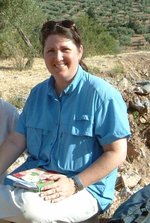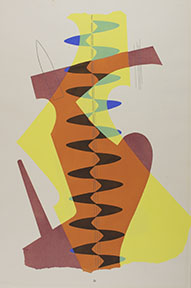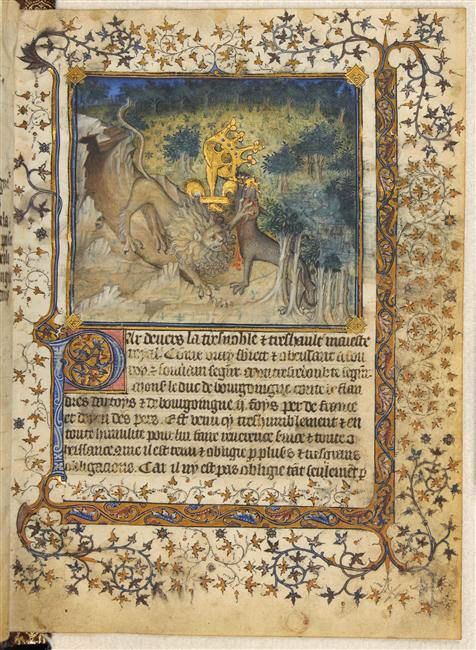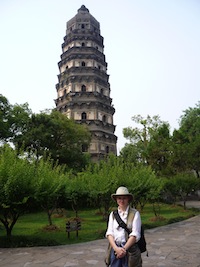Christopher Johns Presents Paper at American Society for Eighteenth-Century Studies
Christopher Johns, Norman L. and Roselea J. Goldberg Professor of History of Art, presented a paper on Saturday, April 1, at the annual meeting of the American Society for Eighteenth-Century Studies in Minneapolis. Johns addressed “Ceremonial Miscommunication or Diplomatic Incompatability?: The Macartney and Amherst Embassies to Qing China, 1793 and 1816.”
The paper was read in the session “Difficulties in Diplomacy: International Relations between European Nations and the ‘Orient’ in the Long Eighteenth Century,” chaired by Nathan D. Brown, Furman University. The American Society for Eighteenth-Century Studies is an interdisciplinary group dedicated to the advancement of scholarship in all aspects of the period—from the later seventeenth through the early nineteenth century.
At the beginning of the fall semester Johns received the Chancellor’s Award for Research. He was recognized for his book The Visual Culture of the Catholic Enlightenment (Penn State University Press, 2014), a culmination of many years of painstaking archival research. It embodies his field-defining contribution to eighteenth-century European cultural history.
Posted by vrcvanderbilt on April 3, 2017 in Conferences, HART, Lectures, VRC
Robert Barsky: Dada Hitchhikes a Ride to America! Lecture on Tuesday, April 4
 Robert Barsky, professor of English and chair of department of French and Italian, will discuss the Beat Generation’s affinity for all things Dada in a talk to be held on Tuesday, April 4, at 5:30 pm in Cohen Memorial Hall, room 203. Barsky will offer examples from the poetry, songs, and general comportment of Allen Ginsberg to show how being “beat” would often overlap with the Dada approach to art and to life.
Robert Barsky, professor of English and chair of department of French and Italian, will discuss the Beat Generation’s affinity for all things Dada in a talk to be held on Tuesday, April 4, at 5:30 pm in Cohen Memorial Hall, room 203. Barsky will offer examples from the poetry, songs, and general comportment of Allen Ginsberg to show how being “beat” would often overlap with the Dada approach to art and to life.
Free and open to the public, the event is presented in conjunction with the Vanderbilt University Fine Arts Gallery’s current exhibition, “The Dada Effect: An Anti-Aesthetic and Its Influence,” which will be open prior to the lecture from 11 am to 5:30 pm. Parking is free of charge in Lot 95, accessible from 21st Avenue South. For more information, please visit the gallery’s website at www.vanderbilt.edu/gallery or call 615-322-0605.
Posted by vrcvanderbilt on April 3, 2017 in Events, Fine Arts Gallery, HART, Lectures, VRC
Kim Shelton to Address Nemea and the Panhellenic Sanctuary of Zeus at the March 30 AIA Lecture
 Kim Shelton, associate professor of classics and director of the Nemea Center for Classical Archaeology, University of California, Berkeley, will deliver the Archaeology Institute of America lecture entitled “Nemea and the Panhellenic Sanctuary of Zeus,” on Thursday, March 30, at 6 pm in the Nashville Parthenon. Shelton will present the Sanctuary of Zeus at Nemea and the history of the pan-Hellenic festival and games celebrated there from the 6th to the 2nd centuries BCE.
Kim Shelton, associate professor of classics and director of the Nemea Center for Classical Archaeology, University of California, Berkeley, will deliver the Archaeology Institute of America lecture entitled “Nemea and the Panhellenic Sanctuary of Zeus,” on Thursday, March 30, at 6 pm in the Nashville Parthenon. Shelton will present the Sanctuary of Zeus at Nemea and the history of the pan-Hellenic festival and games celebrated there from the 6th to the 2nd centuries BCE.
Life on the site began much earlier with habitation during the prehistoric period. Shelton will discuss this evidence along with the possibility of continuity of cult to the establishment of a hero shrine and the establishment of the pan-Hellenic sanctuary in the 6th century BCE. She will examine in detail the festival and games, best known from the 4th century BCE, as well as the unique features and structures of Nemea discovered through excavation by the University of California at Berkeley, especially the initial results of the renewed research on the site during the 2010-2012 seasons under her direction.
Shelton oversees and coordinates the teaching, research, and education activities of the Nemea Center. The central activity of the Center is the excavation, study, conservation, and public presentation of the Sanctuary of Zeus at Nemea, including the Hellenistic Stadium. Among Shelton’s interests are classical archaeology, the Bronze Age Aegean, ceramics, ancient religion and mythology.
This lecture, free and open to the public, is cosponsored by the Archaeological Institute of America, the Vanderbilt University Program in Classical and Mediterranean Studies, and The Conservancy for the Parthenon and Centennial Park. Those who plan to attend the AIA lecture are encouraged to call the Nashville Parthenon at 615.862.8431 to reserve a seat.
Posted by vrcvanderbilt on March 29, 2017 in Events, HART, Lectures, VRC
Moveable Dada (This is Not Your Dada’s Dada!): An Evening of Art, New Music, and Conversation
 Moveable Dada (This is Not Your Dada’s Dada!): An Evening of Art, New Music, and Conversation will be held on Thursday, March 23, beginning at 7 pm in Vanderbilt’s Fine Arts Gallery in Cohen Memorial Hall.
Moveable Dada (This is Not Your Dada’s Dada!): An Evening of Art, New Music, and Conversation will be held on Thursday, March 23, beginning at 7 pm in Vanderbilt’s Fine Arts Gallery in Cohen Memorial Hall.
This program is an exciting collaboration between the Fine Arts Gallery and the Blair School of Music, with the performance of four original student compositions. All are inspired by works of art either in the exhibition or relating to the spirit of Dada. Recordings of these pieces are available through the exhibition audio guide.
Admission and all events are free and open to the public. Visitors to these special events may park free of charge anywhere in Lot 95, accessible from 21st Avenue South. For more information, please visit the gallery’s website at www.vanderbilt.edu/gallery or call 615-322-0605.
*Man Ray
American, 1890–1976
The Meeting, plate IV, from Revolving Doors
Conceptualized as collage, 1916-1917. Printed in Paris, 1926.
Pochoir on paper
22 x 15 inches
© Man Ray Trust / Artists Rights Society (ARS), NY / ADAGP, Paris 2017
Courtesy the Hampshire College Art Gallery
Posted by vrcvanderbilt on March 22, 2017 in Events, Fine Arts Gallery, HART, VRC
Stanley Abe to Address Duplication in Chinese Sculpture in the March 23 Goldberg Lecture
 In China, identical sets of figures, serial images, replications in archaic styles, and later copies were produced over a long period of time. New works were provided with ancient inscriptions; old objects could be inscribed anew. In modern times forgeries meant to deceive collectors proliferated. Duplication was integral to the production of sculpture from ancient times to the present. The study of duplication suggests a way to understand the history of Chinese sculpture as more than a series of unique masterpieces. But attention to duplication also raises many questions and issues for further study.
In China, identical sets of figures, serial images, replications in archaic styles, and later copies were produced over a long period of time. New works were provided with ancient inscriptions; old objects could be inscribed anew. In modern times forgeries meant to deceive collectors proliferated. Duplication was integral to the production of sculpture from ancient times to the present. The study of duplication suggests a way to understand the history of Chinese sculpture as more than a series of unique masterpieces. But attention to duplication also raises many questions and issues for further study.
Stanley Abe, associate professor of art and art history at Duke University, will address “Duplication in Chinese Sculpture” when he delivers the Norman L. and Roselea J. Goldberg Lecture in Art History on Thursday, March 23, at 4:10 pm in Cohen Hall 203. A reception in the Cohen atrium will follow his lecture.
Abe has published on Chinese Buddhist art, contemporary Chinese art, Asian American art, Abstract Expressionism, and the collecting of Chinese sculpture. He is now writing a narrative account of how Chinese sculpture came into existence as a category of “fine art” during the late nineteenth and early twentieth centuries.
He received the Shimada Prize for Ordinary Images (University of Chicago Press, 2002), a richly illustrated book that explores the large body of sculpture, paintings, and other religious imagery produced for China’s common classes from the third to the sixth centuries CE. The Shimada Prize is awarded for distinguished scholarship in the history of East Asian art by the Freer Gallery of Art and Arthur M. Sackler Gallery and by The Metropolitan Center for Far Eastern Art Studies in Kyoto, Japan.
Sponsored by the Department of History of Art, the Goldberg Lecture is free and open to the public. Parking is available in Lot 95 outside Cohen Hall, off 21st Avenue South on the Peabody campus and across from Medical Center East. For more information, call the department at 615.322.2831.
*Buddha, gilt bronze, dated 537, Eastern Wei Dynasty, h. 22 cm, Berenson Art Collection, Villa I Tatti – The Harvard University Center for Italian Renaissance Studies.
Posted by vrcvanderbilt on March 18, 2017 in HART, Lectures, VRC
Lynne Lancaster Examines Unique Building Technique in Roman North Africa for March 16 AIA Lecture
Lynne Lancaster, professor of classics and world religions at Ohio University, will address “Out of Africa: How Roman Olive Oil Production Created Architectural Innovation” in an Archaeological Institute of America lecture scheduled for Thursday, March 16, at 6 pm at the Nashville Parthenon.
 Lancaster will examine a building technique used in Roman North Africa for constructing vaults by means of small hollow terracotta tubes that are inserted one into another and “glued” together with mortar. By examining this unique building technique, she demonstrates how the building industry in North Africa was intimately connected with the production of olive oil destined for Rome and how the use of these tubes ultimately resulted in the creation of new forms of vaulting not found elsewhere in the empire.
Lancaster will examine a building technique used in Roman North Africa for constructing vaults by means of small hollow terracotta tubes that are inserted one into another and “glued” together with mortar. By examining this unique building technique, she demonstrates how the building industry in North Africa was intimately connected with the production of olive oil destined for Rome and how the use of these tubes ultimately resulted in the creation of new forms of vaulting not found elsewhere in the empire.
Recent field surveys have produced a wealth of new information regarding ancient agricultural technology for olive production, ceramic production for the amphoras containing the olive oil, and also fine ware production. The proliferation of the vaulting tubes was also part of this period of economic growth related to increased agricultural production. This unique construction technique eventually was adopted elsewhere in the western Mediterranean, including Rome and Ravenna, where it was used to construct the dome of the Byzantine church San Vitale. Through a series of interconnected technologies, the necessity to provide food for Rome ultimately resulted in a vaulting technique that created spectacular new architectural achievement.
Her interests include Roman architecture, construction and technology, and she has worked on many of the standing structures in Rome, including Trajan’s Markets and the Colosseum, and as architectural consultant at various locations in Italy. She has also conducted surveys of provincial vaulting techniques in Tunisia, Turkey, Egypt, Britain and Greece. Lancaster has published extensively, and her Concrete Vaulted Construction in Imperial Rome: Innovation in Context (Cambridge University Press, 2005) received the AIA’s 2007 James R. Wiseman Book Award. More recently Cambridge published Innovative Vaulting in the Architecture of the Roman Empire: 1st to 4th Centuries CE (2015), which examines six vaulting techniques employed in architecture outside of Rome.
In 2010/2011 Lancaster held the AIA Joukowsky Lecturership. She holds degrees from Virginia Polytechnic Institute and State University (BA in architecture), Lincoln College (MA in classical archaeology), and Wolfson College, Oxford University (PhD in classical archaeology).
This lecture, free and open to the public, is cosponsored by the Archaeological Institute of America, the Vanderbilt University Program in Classical and Mediterranean Studies, and The Conservancy for the Parthenon and Centennial Park. Those who plan to attend the AIA lecture are encouraged to call the Nashville Parthenon at 615.862.8431 to reserve a seat.
Posted by vrcvanderbilt on March 14, 2017 in HART, Lectures, VRC
Fine Arts Gallery Exhibit on Dada and the Continuing Allure of Anti-Art Opens Thursday, March 16
 Recognizing the centenary and far-reaching importance of a pivotal modern art movement, the Vanderbilt University Fine Arts Gallery has partnered with Vanderbilt’s W.T. Bandy Center for Baudelaire and Modern French Studies to present The Dada Effect: An Anti-Aesthetic and Its Influence, an exhibition that will be on view from March 16 through May 27. An opening reception will be held Thursday from 5 to 7 pm in the atrium of Cohen Memorial Hall on the Peabody campus.
Recognizing the centenary and far-reaching importance of a pivotal modern art movement, the Vanderbilt University Fine Arts Gallery has partnered with Vanderbilt’s W.T. Bandy Center for Baudelaire and Modern French Studies to present The Dada Effect: An Anti-Aesthetic and Its Influence, an exhibition that will be on view from March 16 through May 27. An opening reception will be held Thursday from 5 to 7 pm in the atrium of Cohen Memorial Hall on the Peabody campus.
Dada was an international multimedia artistic and literary movement founded in Zurich in 1916 to reimagine and, in fact, tear down prevailing forms of art that had dominated the Western tradition. As early as 1915, while such proto-Dadaists as Marcel Duchamp and Man Ray worked in New York forming their anti-establishment philosophy of art, Zurich Dada was beginning to develop independently in the shadow of the First World War. Following in its aggressively anti-nationalistic, anti-war and anti-bourgeois position, independent Dadaist groups were launched in Paris, Berlin, Cologne and other metropolitan centers.
The Dada Effect shows how Dadaist aesthetics and ideology directly influenced modern art and literature through the twentieth century in many subsequent movements, including Surrealism, ‘Pataphysique, and Neo-Dada. Thanks to the impressive collection of rare books and journals contained within the Pascal Pia Collection held at Vanderbilt’s W. T. Bandy Center for Baudelaire and Modern French Studies, the literary aspect of these movements will be on full display with first editions of works by Tristan Tzara, André Breton, and Jean Cocteau, among many others.
Art from the Vanderbilt University Fine Arts Gallery Collection and several outside loans highlight the connections between various branches of “the arts” (visual, literary, musical, plastic, performance). Works by artists whose imaginations were captured by the notion of anti-art for many decades, including Salvador Dali, Max Ernst, Francis Picabia, Man Ray, Yves Tanguy, Robert Rauschenberg, and John Cage, will play an integral role. The exhibition is also intensely pedagogical, with contributions from students in the Department of Theater and the Blair School of Music.
Special Programs
Moveable Dada (This is Not Your Dada’s Dada!)
An evening of Art, New Music, and Conversation
March 23 at 7:00 pm in the gallery
This program is an exciting collaboration between the Fine Arts Gallery and the Blair School of Music, with the performance of four original student compositions. All are inspired by works of art either in the exhibition or relating to the spirit of Dada. Recordings of these pieces are available through the exhibition audio guide.
Dada hitchhikes a ride to America!
April 4 at 5:30 pm in Cohen 203
Professor Robert Barsky, chair of the department of French and Italian and faculty director of the Bandy Center, will discuss the Beat Generation’s affinity for all things Dada, and he will offer examples from the poetry, the songs, and the general comportment of Allen Ginsberg to show how being “beat” would often overlap with the Dada approach to art and to life.
The Dada Effect: An Anti-Aesthetic and Its Influence is curated by Daniel C. Ridge, assistant director of the W. T. Bandy Center for Baudelaire and Modern French Studies, and organized by the Vanderbilt Fine Arts Gallery, with support provided by the Curb Center for Art, Enterprise, and Public Policy, Leslie Cecil and Creighton Michael (MA’76), Vanderbilt’s Department of French and Italian and Department of Theater, the Jean and Alexander Heard Library, and the Ewers Gift for Fine Art.
The Fine Arts Gallery is located in Cohen Memorial Hall, 1220 21st Avenue South, on the western edge of the
Peabody College campus. Gallery hours from March 16 to April 24 are Monday through Friday 11 am to 4 pm, weekends 1-5 pm; and from April 25 to May 27, Tuesday through Friday 12-4 pm, Saturdays 1-5 pm, closed Sundays and Mondays.
Admission and all events are free and open to the public. Visitors to the opening reception and special events may park free of charge anywhere in Lot 95, accessible from 21st Avenue South. For more information, please visit the gallery’s website at www.vanderbilt.edu/gallery or call 615-322-0605.
Man Ray
American, 1890–1976
The Meeting, plate IV, from Revolving Doors
Conceptualized as collage, 1916-1917. Printed in Paris, 1926.
Pochoir on paper
22 x 15 inches
© Man Ray Trust / Artists Rights Society (ARS), NY / ADAGP, Paris 2017
Courtesy the Hampshire College Art Gallery
Posted by vrcvanderbilt on March 14, 2017 in Events, Fine Arts Gallery, HART, Lectures, VRC
Recognizing Women Artists: Wikipedia ART+FEMINISM Edit-A-Thon at Heard Library on Tuesday, March 14
 “Wikipedia’s gender trouble is well-documented,” said Mary Anne Caton, senior consultant for educational and interpretive programs at the Heard Library. “Art+Feminism is an initiative to improve coverage of women and the arts on Wikipedia, and to encourage female editorship.” HART faculty, staff and students are invited to join other faculty and librarians on Tuesday, March 14, anytime between 11 a.m. and 4 p.m. in Special Collections.
“Wikipedia’s gender trouble is well-documented,” said Mary Anne Caton, senior consultant for educational and interpretive programs at the Heard Library. “Art+Feminism is an initiative to improve coverage of women and the arts on Wikipedia, and to encourage female editorship.” HART faculty, staff and students are invited to join other faculty and librarians on Tuesday, March 14, anytime between 11 a.m. and 4 p.m. in Special Collections.
The event features talks by HART Professor Vivien Fryd and Pamela Gerrish Nunn, Dorothy K. Hohenberg Chair of Excellence, University of Memphis. Nunn will present “Recognizing Mid-19th Century Artists” at 11:00 followed by Fryd on “Feminism 101 and beyond” at 11:15. Lunch will be provided at noon.
“Wikimedia Foundation found that less than 10 per cent of its contributors identify as female,” Caton continued. “While the reasons for the gender gap are up for debate, the practical effect of this disparity is not: content is skewed by the lack of female participation. This represents an alarming absence in an important repository of shared knowledge.”
This event provides an excellent opportunity to learn the basics of Wikipedia editing in a festive, collaborative, thematically focused environment. All are welcome, no experience required. Bring your laptop, power cord, and ideas for entries to edit. All experience levels welcome, and assistance with editing provided. Parking is available at Wesley Place Garage between 19th Avenue South and 21st Avenue South, across from the library.
Posted by vrcvanderbilt on March 14, 2017 in Events, HART, Student/Alumni, Technology, VRC
Premodern Cultural Studies Seminar to Host Elizabeth Moodey’s Talk on February 15 at the Humanities Center
 John the Fearless, Duke of Burgundy, justified the 1407 assassination of his rival, Louis of Orleans, with a contest of emblematic beasts. Elizabeth Moodey, associate professor of the history of art, will address “The Duke of Burgundy as Political Animal” on Wednesday, February 15, from 12 noon to 2:00 pm in the seminar room of the Robert Penn Warren Center for the Humanities.
John the Fearless, Duke of Burgundy, justified the 1407 assassination of his rival, Louis of Orleans, with a contest of emblematic beasts. Elizabeth Moodey, associate professor of the history of art, will address “The Duke of Burgundy as Political Animal” on Wednesday, February 15, from 12 noon to 2:00 pm in the seminar room of the Robert Penn Warren Center for the Humanities.
Of the four manuscripts John commissioned of the Justification du tyrannicide, all three surviving copies are illustrated with a miniature depicting his lion against Louis’s wolf for the crown of France. Louis’s choice of beast, which depended for its effect on a pun with his own name (loup), had to overcome the common medieval reputation of wolves as raveners of sheep, whose actions revealed moral lessons about the Devil. The Burgundian duke chose his beast from the coat of arms of Flanders, a more conventional, even generic choice that was adopted by his son Philip the Good. Under Philip, however, the lion was transformed into something more personal, reflective of the duke’s own character. Poets praised him with heraldic conceits, and the lion was brought back into circulation on his coins.
The Premodern Cultural Studies Seminar is hosting Moodey who teaches the history of illuminated manuscripts, the culture of the Burgundian court, and the art of medieval Europe, with an emphasis on materials and technique and questions of patronage. Her book, Illuminated Crusader Histories for Philip the Good of Burgundy (Brepols Publishers, 2012), examines the varieties of history writing and the visual and literary projects initiated at the duke’s court before and after the Fall of Constantinople in 1453.
Lunch will be provided. If you have any questions about Professor Moodey’s talk, or about the premodern cultural studies seminar, please contact one of its organizers: Bill Caferro (william.p.caferro@vanderbilt.edu), Samira Sheikh (samira.sheikh@vanderbilt.edu), and Jessie Hock (jessie.hock@vanderbilt.edu).
*“The Lion Attacking the Wolf,” from Justification du tyrannicide, Musée Condé, Chantilly, France.
Posted by vrcvanderbilt on February 13, 2017 in HART, Lectures, VRC
Tracy Miller Among Inaugural Mellon Faculty Fellows for Vanderbilt’s Center for Digital Humanities
 More than 100 faculty and students recently filled Vanderbilt’s new Center for Digital Humanities to celebrate a dynamic hub in Buttrick Hall for scholarly projects using digital tools. The center will be home each year to a cohort of faculty, postdoctoral, graduate and undergraduate students seeking digital approaches to humanistic scholarship. In addition, it will serve as a resource for faculty and students who seek an introduction to digital humanities.
More than 100 faculty and students recently filled Vanderbilt’s new Center for Digital Humanities to celebrate a dynamic hub in Buttrick Hall for scholarly projects using digital tools. The center will be home each year to a cohort of faculty, postdoctoral, graduate and undergraduate students seeking digital approaches to humanistic scholarship. In addition, it will serve as a resource for faculty and students who seek an introduction to digital humanities.
The Center for Digital Humanities was awarded a $1.5 million grant from the Andrew W. Mellon Foundation to support digital exploration in the humanities. It is receiving additional support from the Office of the Provost and the College of Arts and Science.
“I am profoundly grateful to the Mellon Foundation for making possible this state-of-the-art center,” said Lauren A. Benton, Nelson O. Tyrone Jr. Professor of History and dean of the College of Arts and Science. “I was thrilled to find a strong group of scholars already working in the digital humanities across several schools, departments, centers and the library when I arrived at Vanderbilt in 2015. This new center will bring scholars together to learn from one another as they advance innovative research projects across the humanities.”
Benton recognized the inaugural group of Mellon Faculty Fellows for 2016-2017:
• Lynn Ramey, associate professor of French, who is developing immersive 3D environments in research and teaching on the Middle Ages;
• Jane Landers, Gertrude Conaway Vanderbilt Professor of History, who is constructing a digitized archive of endangered sources on the lives of slaves across the Americas;
• Tracy Miller, associate professor of history of art, who is applying digital tools to understanding traditional Chinese architecture; and
• Steven Wernke, associate professor of anthropology, who gave a short presentation on his use of advanced spatial analysis to enhance archaeological research in the Andes.
The Traditional Chinese Architecture Digital Research Tool is focused “on our earliest extant examples of timber-frame architecture in China, largely dating from the 8th-13th centuries, and includes information on construction techniques as well as stylistic features,” said Miller. “The vast majority of these buildings were constructed for ritual purposes; therefore data on style and structure of the buildings, as well as epigraphic information on site concerning patronage, have the potential to enhance not only our understanding of the aesthetics of traditional Chinese architecture over time and space, but also our understanding of the trade networks, crafts traditions, and spiritual aspirations of people living in pre-modern China.”
For more information, visit the Center for Digital Humanities website or email Mickey Casad, senior lecturer in the Program in Cinema and Media Arts and the Center’s associate director.
*Ann Marie Deer Owens (My VU, February 6, 2017) contributed to this blog post.
Posted by vrcvanderbilt on February 10, 2017 in Events, HART, Technology, VRC

©2025 Vanderbilt University ·
Site Development: University Web Communications